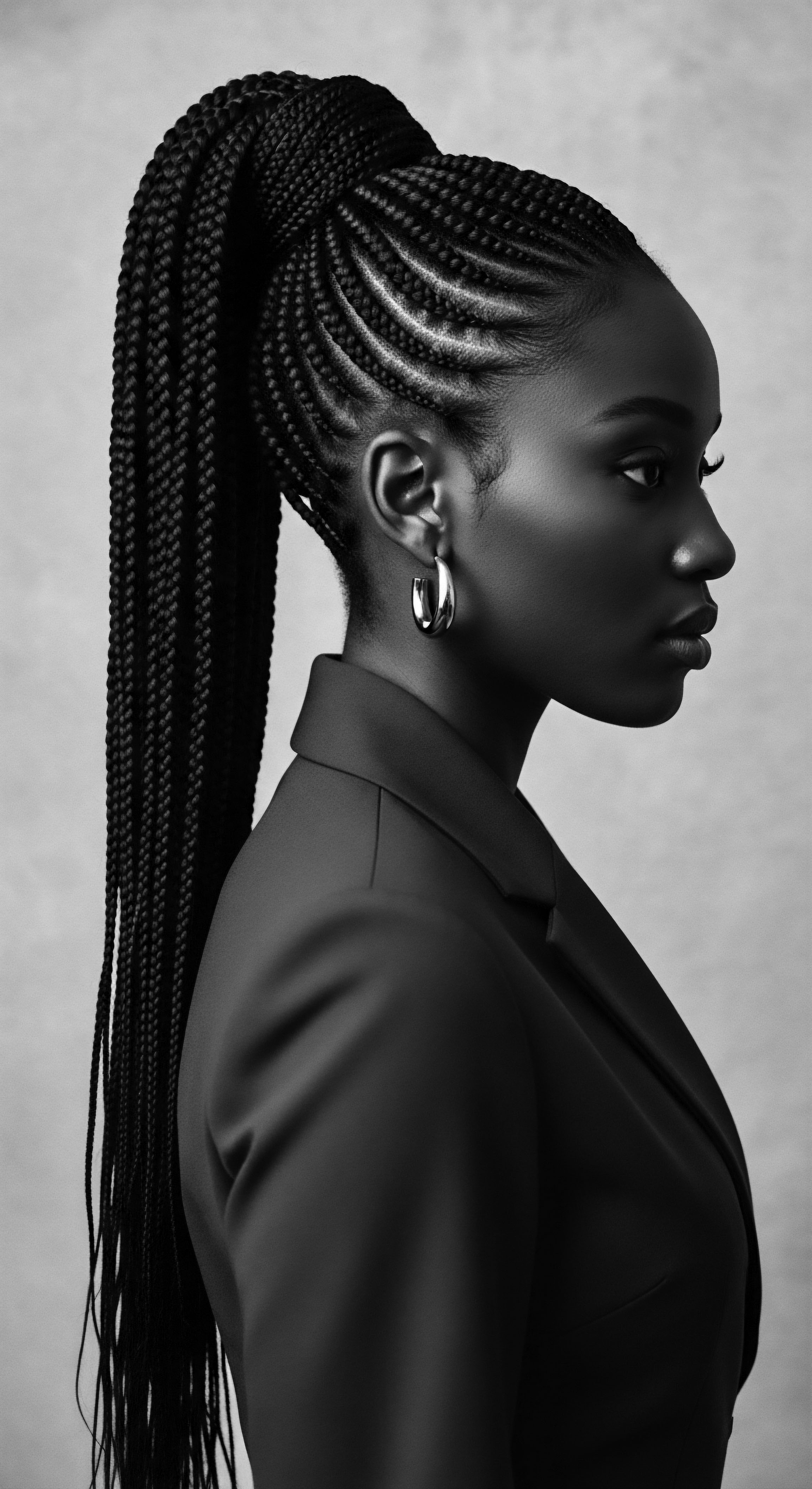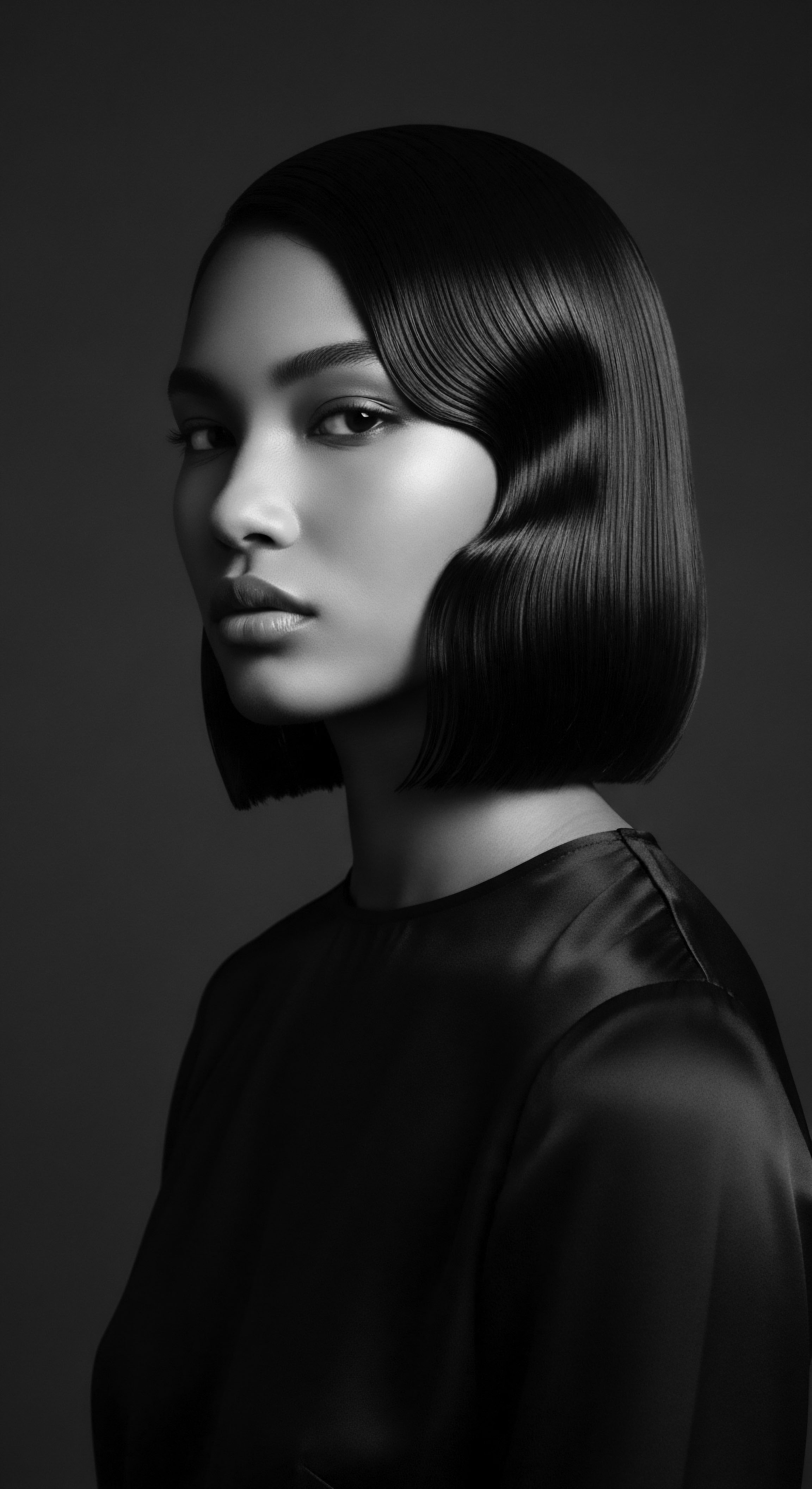The story of textured hair, especially within Black and mixed-race communities, is a vibrant chronicle of resilience, identity, and ingenuity. It is a story told not just through strands, but through the earth itself, for historical clay practices hold a profound, often understated, influence on our modern hair rituals. This connection is not merely one of shared ingredients but a deep, ancestral echo, linking contemporary care to ancient wisdom.
From the purifying dust of volcanic ash to the protective layers painted on warriors, clay has been a quiet constant, a silent partner in the enduring dialogue between humanity and its coiled, crimped, and kinky crowns. It is a testament to how the gifts of the land have always been understood, intuitively, as fundamental to our being.

Roots
The very concept of hair care, particularly for textured strands, finds its origins deeply embedded in the earth’s embrace. Long before the era of synthesized solutions, our forebears looked to the ground beneath their feet, finding in various clays an elemental answer to cleansing, fortifying, and adorning their hair. This ancestral wisdom, passed through countless hands and generations, forms the invisible bedrock of many modern hair rituals, whether we consciously recognize its lineage or not.

Ancestral Earth, Elemental Care
Clay, in its rawest form, is an ancient cosmetic. Evidence shows civilizations across continents, from Egypt to Mesopotamia, harnessed the purifying properties of natural clays for their grooming rituals. These early innovators recognized clay’s ability to absorb excess oil and draw out impurities without stripping hair of its natural moisture, a balance many contemporary textured hair enthusiasts still seek. This innate understanding of the material’s power speaks to a profound connection with the environment, a reciprocity where the earth provided sustenance for both body and spirit.
The geological diversity of clay minerals, from the swelling Bentonite to the absorbent Kaolin, meant different regions developed practices tailored to their local earth. This regionality speaks volumes about the adaptable nature of ancestral hair care, demonstrating how communities made do with what was readily available, turning geological offerings into cherished beauty traditions. The very structure of clay, composed mainly of fine particles of hydrous aluminum silicates and other minerals, grants it its unique properties for absorbing and binding with impurities.
Consider the significance of white clay, extracted from the soils around the Nile River, which served cleansing and spiritual purposes in ancient Egypt as early as 10,000 BCE. Its white hue signified cleanliness and godliness, reflecting a holistic view of beauty intertwined with spiritual purity. This intertwining of the practical with the sacred reveals a foundational aspect of ancestral practices, where self-care transcended mere aesthetics to become a spiritual act.
Ancient clay practices demonstrate a fundamental, intuitive connection between the earth’s resources and the deeply understood needs of textured hair, long before scientific validation.

Textured Strands, Timeless Solutions
The architecture of textured hair, with its unique coiling and bending patterns, presents specific care needs, including moisture retention and gentle cleansing. This is where clay, with its mineral-rich composition, often provided suitable solutions. The ability of certain clays to act as a mild surfactant and a clarifying agent, without harsh stripping, aligns remarkably with the requirements of maintaining curl integrity and scalp health.
Even the earliest forms of what we might identify as “shampoo” involved clay. Babylonian courts, around 3000 BCE, stored soap-like materials made from animal fats boiled with ashes in clay jars. While not clay as the cleansing agent directly, the vessel itself speaks to the ubiquity of clay in daily life and its role in containing and thus enabling hair care rituals. This early history points to a continuous engagement with natural elements to maintain healthy hair.
One might observe the profound logic in utilizing earth-derived materials. Our ancestral kin, with hair types spanning the spectrum of texture, recognized the hydrophilic properties of clay—its readiness to mix with water, creating a paste that could effectively lift dirt and excess oil from the scalp and strands. This basic chemical interaction was understood through generations of observation and practical application, a wisdom passed down through touch and ritual rather than scientific texts.
- White Clay ❉ Used in ancient Egypt for purification and spiritual rituals.
- Red Ochre Clay ❉ Employed by communities like the Himba for sun protection, cleansing, and cultural adornment.
- Rhassoul Clay ❉ Valued in North Africa for centuries as a gentle cleanser and hair fortifier.

Ritual
The journey from raw earth to a sacred hair practice involved intention, community, and repeated action—the essence of ritual. Historical clay practices were rarely solitary acts; they were often communal, imbued with cultural significance, and tailored to specific textured hair needs. This transformation from a simple application to a profound ritual speaks to the deeper influence clay has held, shaping not only hair appearance but also identity and belonging.

Clay’s Cultural Canvas and Ancestral Adornment
Across diverse cultures, particularly in Africa and among indigenous peoples, clay took on roles beyond mere cleansing. It became a medium of expression, a protector, and a marker of status. The application of clay was not a fleeting trend; it was a deeply ingrained custom, often tied to rites of passage, social standing, and protection from the elements. This layering of utility with symbolism allowed clay to solidify its place within the heritage of textured hair care.
Consider the Maasai warriors of Kenya and Tanzania. They traditionally wear their hair in long, micro-braided strands, which they then dye with a distinctive reddish color derived from a mixture of red ochre clay and animal fat. This isn’t just about appearance; it’s a powerful statement of masculinity, strength, and courage. The clay not only provides the striking hue but also acts as a stiffener and protector for these elaborate styles.
| Community/Region Himba people (Namibia) |
| Type of Clay Used Red Ochre |
| Primary Hair Use (Historical) Sun protection, cleansing, cultural adornment, styling with butterfat. |
| Community/Region Maasai (Kenya/Tanzania) |
| Type of Clay Used Red Ochre |
| Primary Hair Use (Historical) Coloring and stiffening warrior braids, symbolizing status. |
| Community/Region North Africa (Morocco) |
| Type of Clay Used Rhassoul Clay |
| Primary Hair Use (Historical) Gentle cleansing, hair masks in hammam rituals. |
| Community/Region Dakota/Sioux/Blackfoot (Native American) |
| Type of Clay Used Red Ochre Clay |
| Primary Hair Use (Historical) Stiffening scalplocks and pompadours. |
| Community/Region These examples underline clay's enduring utility and cultural significance in shaping textured hair traditions across global heritages. |
The Himba women of Namibia, renowned for their striking appearance, embody this tradition with their daily application of Otjize, a paste made from red ochre clay, butterfat, and sometimes aromatic resin. This practice serves multiple purposes ❉ it protects their hair and skin from the harsh desert sun, acts as a cleanser in a water-scarce environment, and signifies their cultural identity and beauty. The intricate details paid to these elaborate hairstyles, often beginning from infancy, underscore the deep cultural value placed on hair within the Himba community.

How Did Clay Practices Become Integrated into Community Life and Identity?
The integration of clay practices into community life was a natural progression. The materials were local, effective, and provided tangible benefits. Beyond the physical effects on hair, the communal aspects of preparing and applying these clay mixtures fostered bonds. Shared rituals, whether for daily care or special ceremonies, reinforced social structures and preserved ancestral knowledge.
This communal application is clearly observed within the Maasai, where warriors spend hours braiding each other’s hair, a practice that builds camaraderie and strengthens group identity. The act itself becomes a living archive, a way to pass down techniques and the meaning behind them.
From protective layers against harsh sun to markers of social standing, historical clay practices were deeply woven into the cultural fabric, celebrating and preserving textured hair heritage.
For many indigenous groups, hair was considered sacred—a spiritual extension of the self. Applying clay, a gift from the earth, served as a symbolic connection to nature and the divine. This reverence meant hair care was not a superficial act but a profound engagement with one’s heritage and the natural world.
The consistent, generational use of specific clays within communities allowed for an experiential understanding of their properties, creating a living pharmacopeia of hair care. This empirical knowledge, honed over centuries, is a powerful example of how ancestral wisdom served as the first form of scientific inquiry, proving effectiveness through repeated observation and successful outcomes.

Relay
The echoes of historical clay practices reverberate through modern hair rituals, revealing a continuous dialogue between ancient wisdom and contemporary understanding. The foundational principles governing clay’s interaction with hair – its absorptive capacity, mineral contribution, and gentle cleansing – are still highly relevant. Today, we observe these historical influences in the natural hair movement, particularly for textured hair, where there is a conscious return to earth-derived ingredients, often validating ancestral methods with modern scientific inquiry.

Do Modern Clay Treatments Replicate Ancient Formulations?
Modern clay hair masks and cleansers often employ minerals like bentonite, kaolin, and rhassoul, the very same types used for centuries. While the packaging and marketing differ, the fundamental interaction between these clays and textured hair remains rooted in their historical application. Bentonite clay, for instance, known since ancient times for its therapeutic benefits, is celebrated today for its ability to draw out positively charged toxins and excess oils from hair and scalp due to its poly-cationic nature.
The “detoxifying” and “clarifying” benefits often attributed to modern clay hair treatments directly parallel the cleansing and purifying functions documented in ancient practices. In some places, such as Iran, bentonite clay has been a hair cleanser for a long time. This enduring application speaks to an innate efficacy, which contemporary science now seeks to explain. The idea of using clay to “reset” the hair and scalp, removing buildup from modern styling products or environmental pollutants, is a continuation of ancient purification rituals that prepared the hair for adornment or spiritual practices.
For instance, rhassoul clay, mined from the Atlas Mountains of Morocco, continues to be a staple. It is rich in silicon and magnesium, which contribute to strengthening hair and scalp. Historically, it was mixed with black soap for washing hair, and its use remains a core part of the traditional Moroccan hammam ritual. The modern application of rhassoul as a natural shampoo or hair mask, without stripping natural hydration, directly reflects its historical purpose and effectiveness.

How Does Scientific Understanding Confirm Ancestral Wisdom Regarding Clay’s Hair Benefits?
While direct scientific studies specifically on bentonite clay’s effects on human hair are limited, a review in the Iranian Journal of Public Health observed that bentonite clay contributes to quicker, softer wool growth in sheep. This suggests a biological interaction with keratinous fibers, hinting at mechanisms that could apply to human hair. Modern research into the mineral composition of clays, such as magnesium silicate in rhassoul, confirms their capacity to cleanse and revitalize without causing dryness. This provides scientific backing for the ancestral observations of clay’s gentle yet effective cleansing properties.
The cleansing action of clays comes from their unique layered structure and negative electrical charge when hydrated. This allows them to attract and bind with positively charged impurities, oils, and product buildup on the hair and scalp. This “magnetic” action, a scientific explanation of what was once experienced as simple cleansing, validates the ancestral choice of clay as a primary hair purifier.
Modern hair care’s embrace of mineral clays serves as a tangible continuation of ancestral practices, with contemporary science now illuminating the ‘why’ behind enduring traditional benefits.
The Himba people of Namibia, as previously discussed, coat their hair and bodies in a red ochre paste (otjize) daily. Archaeologist Dr. Riaan Francois Rifkin’s 2012 thesis at the University of Witwatersrand reported that the red ochre applied by Himba women offers significant protection against UV rays and acts as a mosquito repellent. This rigorously backed finding provides a powerful scientific validation for a deeply ancestral practice, showcasing how historical clay uses offered practical, protective benefits beyond mere aesthetics for textured hair in harsh environments.
This intersection of empirical ancestral knowledge and modern scientific validation creates a richer understanding of textured hair heritage. It encourages us to look at traditional practices not as mere folklore, but as sophisticated systems developed over millennia, often with sound, albeit unarticulated, scientific principles underpinning them. The continuity of clay use serves as a powerful reminder that the past holds valuable lessons for the future of hair care.
The ancestral knowledge, often passed down orally and through communal practice, understood the benefits of clay through observation ❉ how hair felt after a clay wash, how it responded to styling with clay, or how it seemed protected by clay. These observations, consistent over generations, formed a robust foundation of care. Today, when a natural hair enthusiast reaches for a jar of bentonite clay, they are, in a profound way, participating in a lineage that spans millennia, connecting them to a global heritage of earth-centered beauty rituals.
Beyond cleansing, clays offer additional mineral content that can contribute to overall scalp health. The presence of minerals like silica, magnesium, iron, and calcium in clays like rhassoul and bentonite contributes to healthier hair follicles and potentially stimulates growth. This mineral infusion, a subtle yet substantial benefit, aligns with holistic wellness philosophies that view hair health as an extension of overall bodily well-being, a concept central to many ancestral traditions.
- Detoxification ❉ Clays absorb impurities and heavy metals, a property valued historically and presently for scalp cleansing.
- Mineral Enrichment ❉ They offer beneficial minerals like silica, magnesium, and calcium, supporting hair strength.
- Gentle Cleansing ❉ Clay provides effective cleansing without stripping natural oils, maintaining hair’s inherent moisture balance, which is crucial for textured hair.

Reflection
The journey through historical clay practices and their reverberations in modern hair rituals brings us back to the very soul of a strand ❉ its heritage. Textured hair, in its myriad coils and patterns, carries the indelible marks of ancestral ingenuity and resilience. The enduring presence of clay, from the ochre-dyed braids of Maasai warriors to the rhassoul masks of North African hammams, serves as a testament to the timeless wisdom embedded within our collective past. These aren’t just ancient remedies; they are living traditions, adapting and transforming, yet always holding true to their elemental origins.
As we navigate the complexities of contemporary hair care, the lessons from these historical clay practices call us to a deeper engagement with our hair. They beckon us to consider not just the superficial appearance but the holistic well-being of our strands, understanding their connection to the earth, to community, and to identity. The choice to incorporate natural clays today, whether for a clarifying wash or a fortifying mask, is more than a product selection; it is an act of honoring, a conscious step towards reclaiming and celebrating the profound heritage of textured hair.
This enduring legacy reminds us that true innovation often lies in returning to the source, in rediscovering the elemental truths that our ancestors intuitively knew. The story of clay and hair is a vibrant chapter in the larger narrative of human connection to nature, a gentle whisper from the past that continues to guide our hands and nourish our roots, ensuring that the spirit of our strands remains unbound.

References
- Kalu, Anthonia. “The Human Element in the Oral Tradition.” Research in African Literatures, vol. 30, no. 1, 1999, pp. 165–75.
- Cole, Herbert M. and Chike C. Aniakor. Igbo Arts ❉ Community and Cosmos. Museum of Cultural History, University of California, Los Angeles, 1984.
- Rifkin, Riaan Francois. “Preliminary Results Indicate That The Red Ochre Applied By Himba Women Confers A Significant Degree Of Protection Against Uv Rays.” PhD thesis, University of the Witwatersrand, 2012.
- Lambert, Michael. “Ceramics and History in Southeast Asia.” Journal of Southeast Asian Studies, vol. 32, no. 2, 2001, pp. 263–79.
- Amonette, James E. and Lawrence J. Zelazny. “Clay Mineral Chemistry.” Minerals in Soil Environments, 1995, pp. 317–401.
- Chaudhri, S.K. and N.K. Jain. “Cosmetic Clays ❉ A Review.” Journal of Applied Cosmetology, vol. 27, no. 1, 2009, pp. 1-13.
- Gomes, Celso de Souza Furtado, and Janine de Vasconcelos Silva. Clays and Clay Minerals in Cosmetics and Dermatological Formulations. Geological Society, London, Special Publications, 2007.
- Hirst, L.P. “Indigenous Knowledge Systems in Southern Africa.” Southern African Journal of Environmental Education, vol. 20, 2000, pp. 11-18.
- Willis, R.G. The Ethnography of Ancient Egypt. Oxford University Press, 1989.
- Ekosse, Georges-Ivo E. “The Mineralogy, Geochemistry and Genesis of the Clay Deposits in the Mahalapye Area, Botswana.” Applied Clay Science, vol. 16, no. 5-6, 2000, pp. 279-94.
- Guggenheim, Stephen, and Ronald T. Martin. “The Geology of Clay Minerals.” Reviews in Mineralogy and Geochemistry, vol. 49, no. 1, 1995, pp. 1-32.
- Nkoma, J.S. and G.I.E. Ekosse. “X-ray Diffraction, SEM and Mössbauer Spectroscopy Investigations of Clays from the Mahalapye Area, Botswana.” Journal of African Earth Sciences, vol. 29, no. 2, 1999, pp. 273-82.
- Righi, D. and J.D. Meunier. “Clay Mineralogy of Tropical Soils.” European Journal of Soil Science, vol. 46, no. 2, 1995, pp. 219-32.
- Velde, B. Origin and Mineralogy of Clays ❉ Clays and the Environment. Springer, 1995.
- Juch, J.H. et al. “Effect of Clay-Containing Preparations on Skin Irritation Caused by Sodium Lauryl Sulfate.” Skin Pharmacology and Applied Skin Physiology, vol. 7, no. 2, 1994, pp. 116-23.
